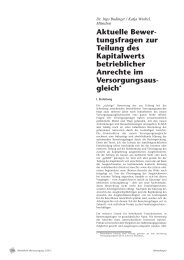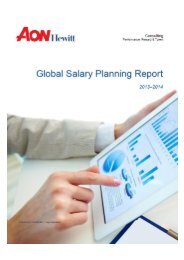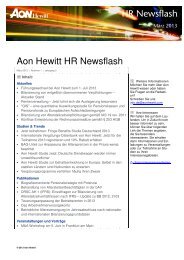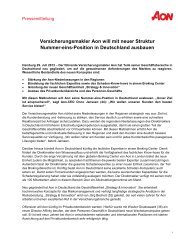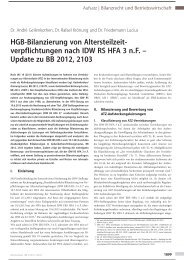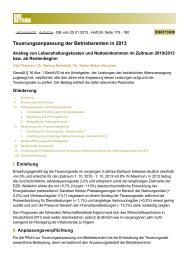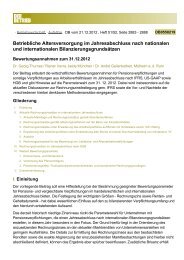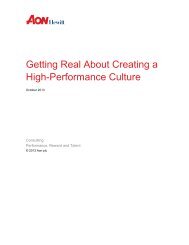Insurance Risk Study - Aon
Insurance Risk Study - Aon
Insurance Risk Study - Aon
You also want an ePaper? Increase the reach of your titles
YUMPU automatically turns print PDFs into web optimized ePapers that Google loves.
Managing Inflation <strong>Risk</strong><br />
<strong>Risk</strong> managers today recognize inflation as a potential<br />
threat in the years ahead, but struggle to quantify the<br />
risk and identify ways to mitigate it. The historical record<br />
reminds us that periods of high inflation have occurred<br />
repeatedly in virtually every economy. But during the<br />
last 25 years, inflation has been contained at low levels<br />
in the U.S. and other developed economies. As a result,<br />
the time series available to measure inflation’s impact on<br />
the current insurance industry will not serve us well in<br />
anticipating the next potential inflation shock.<br />
Inflation 1914-2009<br />
20%<br />
15%<br />
10%<br />
5%<br />
0%<br />
-5%<br />
-10%<br />
-15%<br />
1910<br />
Impact on Insurers<br />
Periods of high inflation, and high inflation volatility in<br />
particular, have generally preceded periods of rising<br />
accident year combined ratios.<br />
Inflation and Combined Ratio<br />
14%<br />
12%<br />
10%<br />
8%<br />
6%<br />
4%<br />
2%<br />
0%<br />
1970<br />
1975<br />
1930<br />
1980<br />
1985<br />
1950<br />
1990<br />
1970<br />
1995<br />
This lagged relationship between inflation and<br />
combined ratios is driven by three factors:<br />
> Lags between the incidence of inflation rate changes<br />
and recognition in loss reserving systems and rate<br />
indications<br />
> Lags between attempts to raise rates and actual<br />
rate changes due to regulatory and competitive<br />
limitations<br />
> Immediate impact on balance sheets<br />
1990<br />
Combined Ratio<br />
Inflation<br />
2000<br />
2005<br />
2010<br />
125%<br />
120%<br />
115%<br />
110%<br />
105%<br />
100%<br />
95%<br />
90%<br />
Industry Balance Sheet Impact<br />
<strong>Aon</strong> Benfield<br />
In the table below we demonstrate the last of these<br />
three effects for U.S. insurers using the 2009 industry<br />
balance sheet and the sensitivity of bond holdings,<br />
equity holdings and nominal loss reserves to changes<br />
in inflation. We show that a 200 basis point increase<br />
in inflation could result in a $70.9 billion impact on<br />
surplus, a 13.7 percent decrease.<br />
Impact of Inflation Increase on Industry Balance Sheet<br />
Assets<br />
Balance<br />
($B)<br />
Pre-tax<br />
Sensitivity<br />
%<br />
After-Tax<br />
Sensitivity<br />
%<br />
After-<br />
Tax Impact<br />
($B)<br />
Bonds 866.3 -7.3% -4.7% -40.9<br />
Stocks 227.0 -6.0% -3.9% -8.9<br />
Other Assets 398.9 0.0% 0.0%<br />
Total Assets 1,492.2 -5.1% -3.3% -49.7<br />
Liabilities<br />
Net Loss Reserves 564.0 5.8% 3.8% 21.2<br />
Other Liabilities 411.4 0.0% 0.0%<br />
Total Liabilitites 975.4 3.3% 2.2% 21.2<br />
Surplus 516.8 -21.1% -13.7% -70.9<br />
The primary drivers of these changes are bonds, stocks<br />
and loss reserves.<br />
Bonds — Changes in inflation affect bond yields<br />
differently for bonds of different maturities. Overall, a<br />
200 basis point increase in inflation would be expected<br />
to decrease the value of the industry bond portfolio by<br />
7.3 percent.<br />
Stocks — Stock portfolios are often assumed to have<br />
a high sensitivity to changes in bond yields. However,<br />
since empirically 80 percent of changes in inflation<br />
expectations ultimately flow through the S&P 500 as<br />
higher nominal dividends, this significantly offsets the<br />
effect of discounting these dividends at higher yields.<br />
The overall affect is approximately a 6.0 percent decline<br />
in the value of a diversified equity portfolio for a 200<br />
basis point change in inflation.<br />
Loss Reserves — The impact of inflation, particularly<br />
when measured as changes in the broad CPI-U,<br />
varies by line of business. Many short-tailed lines are<br />
impacted directly, though modestly, as a result of<br />
their quick settlement. In contrast, long-tailed lines<br />
are impacted more significantly by components of the<br />
CPI-U, which results in a more muted relationship to<br />
general inflation. Overall, for the industry reserves, we<br />
estimate a 5.8 percent increase in undiscounted loss<br />
reserves for a 200 basis point increase in inflation.<br />
19



